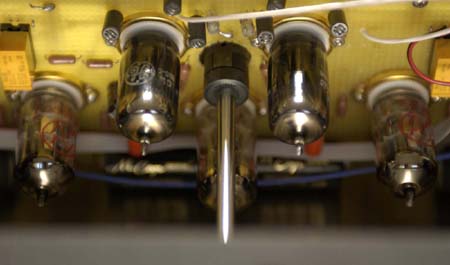News
October 2009 - The Audio Archive is proud to announce that the first Wavestream Kinetics Archival Phono Stages are shipping to customers.

Archival Phono Stage
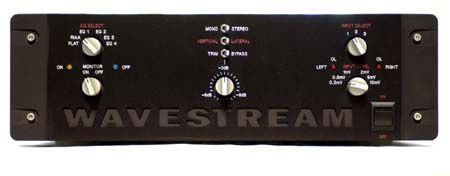
The Audio Archive and Wavestream Kinetics teamed together to produce a unique archival phono preamp with no-compromise sonic accuracy as its sole goal while also providing an unprecedented level of flexibility needed to preserve and re-master historic phonograph recordings in any grooved format (cylinder, 78 shellac, transcription disc, dictation disc, 45 or LP).
Learn about the Wavestream Kinetics Archival Phono Stage for state-of-the-art playback, preservation and re-mastering in the following sections:
A New Level of Accuracy and Flexibility
Archival Phono Stage Features
Modular EQ Cards
Front panel EQ selection of up to six EQs
Direct output to ADC and playback monitor
Lateral and vertical groove switch
Mono sum switch
Trimming and nulling of the difference signal
Engraved front panel labels
Modular precision cartridge loading
Up to three tonearm inputs
Phono i nput levels from 0.2 mV to 10 mV
Tool-less service design
Rounded case edges and corners
Large form factor
Build quality examplesAudio Circuit
Power SupplyEQ Options
EQ Performance Specifications
Our Story
Why Tubes
About Scott Frankland and Wavestream Kinetics
FAQ
A New Level of Accuracy and Flexibility
Attempting to serve two masters - accuracy and flexibility – can often lead to compromises. Wavestream Kinetics has addressed this conundrum through a unique modular preamplifier approach that provides both flexibility and circuit simplicity.
Below are the design challenges and corresponding design philosophies to meet those challenges.
Design Challenge: The traditional archival phono stage cannot be made flexible enough to cover every transcription contingency. Variable filter values cannot be made both simultaneously infinite and accurate.
Design Challenge: The traditional archival phono stage tries to do too much with too little. Allowing the operator to combine individual filter values (ie. low bass, bass and treble turnovers) is not desirable because there can be interaction among filters producing inaccuracy in the overall curve (see Stanley Lipshitz, On RIAA Equalization Networks, Journal of the Audio Engineering Society, Jun 1979, 27:6, pg. 476). Conventional solutions either limit choices or add filters and stages (such as buffers) to overcome these problems.
Design Challenge: Corrective filters and stages can color the sound. We do not believe the basic analog engine or circuit should be compromised.
Design Philosophy: We have kept our circuit as pure and simple as possible without compromising either flexibility or accuracy.
Design Philosophy: Simplicity is best approached by using triode vacuum tubes. Triodes have the most benign distortion spectra in simple circuits (See Eric Barbour, The Cool Sound of Tubes). We use 4 triodes configured in two gain stages to produce 60dB of gain at 1kHz. No transformers are used as a gain stage.
See also Peter J. Baxandall, "Audio Power Amplifier Design," Wireless World, Dec 1978, Feb 1979.
Four 6DJ8 triode vacuum tubes for left and right input and output. The single 12AX7 for the Left-Right cascode circuit is visible just beneath the mechanical control shaft in the center. The mechanical control shaft is used to minimize low-level signal path lengths.
Design Philosophy: In pursuit of greater transcription accuracy our approach is to design dedicated modular EQ blocks that are as true to their original curves as possible. We do not provide adjustments or variations that might affect accuracy due to filter interactions or added stages. We design accuracy into the curve for you. Our networks are based on extensive research by noted authorities.
Design Philosophy: Details matter, even the seemingly smallest ones. All those details ultimately add up to great performance.
The Audio Archive is a state-of-the-art transfer facility, serving the needs of major sound collections, institutions, record labels and film companies. Using our deep experience in the preservation industry, the Wavestream Kinetics Archival Phono Stage was truly "designed by archivists, for archivists." Features are practical and meaningful, performance is un-equaled by any other phono preamp for archival and re-mastering use, and it is designed for long life and easy service.
Coupled with the audio engineering expertise of Scott Frankland, we've delivered a highly unique, dynamic, harmonically accurate and precise phono stage for truly cutting edge preservation and re-mastering work.
What follows are the features and highlights of the Wavestream Kinetics Archival Phono Stage...
Feature: Our EQ networks are infinitely flexible because each EQ module is built to spec, and the EQ modules are easy to install or change. We design EQ cards not only for the well known curves (RIAA, NAB, AES, Columbia, Decca FFRR, Blumlein, Western Electric, etc.) but also for any label for which a known recording curve exists; including EQ cards for label variations such as occur during transitions from one EQ standard to another. Our FLAT EQ is accurate to +/- 0.1 dB from 20 Hz to 20,000 Hz. Such precision is especially important when making preservation masters from mono recordings using a stereo cartridge.
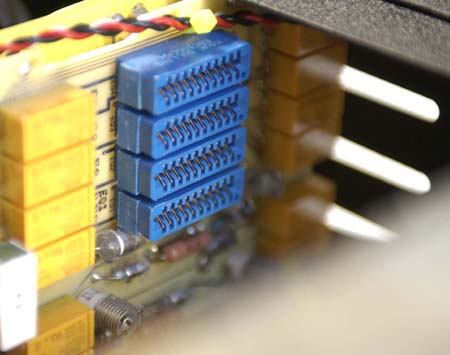
Four EQ (Equalization) card slots can be easily accessed inside the case. Selection between RIAA, FLAT and up to four EQs are all made from the switch on the front panel. The $32,000 Boulder Model 2008 solid-state phono preamp is the only other preamp to take such a modular approach to custom EQ.
Feature: Archivists can select either FLAT or RIAA from the front panel. In addition to these two standard EQs, the same switch also selects from up to four additional plug-in EQ cards for a total of six precision EQs from which to select at any time. EQ cards can be ordered at any time; custom cards are available by special order. EQ cards can be easily swapped.

Every Archival Phono Stage comes standard with RIAA and FLAT equalizations. Up to four optional EQs can be selected.
Feature: A separate switched monitor output is provided allowing both direct monitoring of the Archival Phono Stage during disc playback AND direct output from the Archival Phono Stage to the ADC. The direct connection between the phono stage and the ADC minimizes any possible signal alteration and degradation.
Feature: The Archival Phono Stage includes a lateral-vertical switch and mono sum switch, both of which are necessary when working with early grooved disc and cylinder media.
Feature: For re-mastering and precision preservation work of mono recordings, the phono input signal can be precisely trimmed and nulled by listening to the difference signal. No other phono preamp today offers this critical trimming capability needed for minimizing groove wall noise and evaluating stylus-groove fit. The trim feature can be electrically by-passed if you do not need it, thus keeping the phono stage circuit as simple and pure as possible at all times. Below are images of how this works.
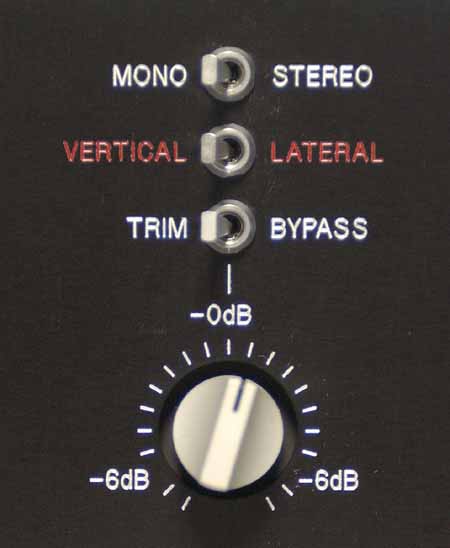
With the TRIM feature engaged and the phase of one channel reversed (VERTICAL setting) and then summed to MONO, it is possible listen to the difference between the left and right groove walls. The left and right signals can be optimized for maximum noise cancellation (mono recordings) using the TRIM control. The Wavestream Kinetics Archival Phono Stage is the only phono preamp available with this critical preservation and re-mastering capability.
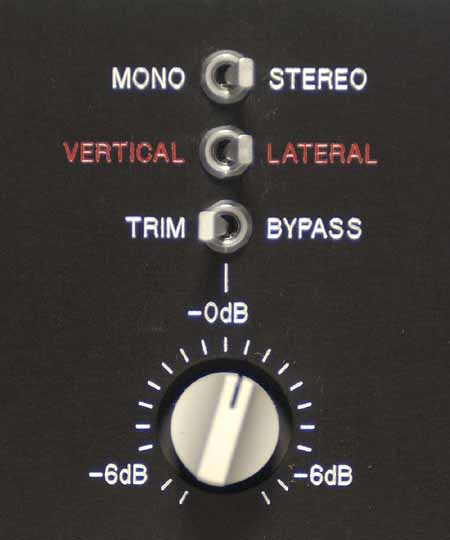
Once you have optimized the TRIM value for maximum groove wall noise cancellation on your mono recording, simply switch back to LATERAL and STEREO to digitize and create your master for preservation or re-mastering.
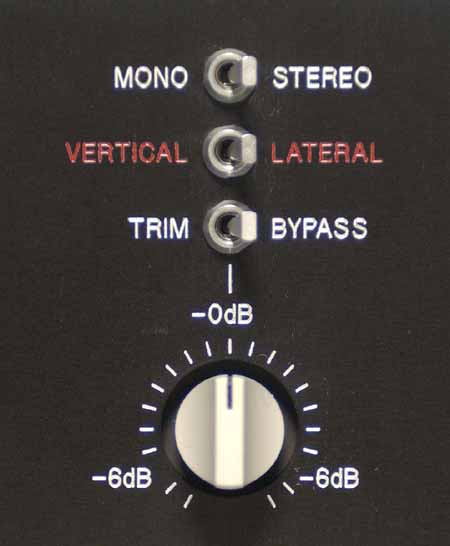
Audiophile quality stereo transfers can be made by simply by-passing the TRIM function. This removes the TRIM circuitry from the phono stage for optimal stereo playback.
Feature: Engraved labels on the front panel. All the controls are engraved directly into the metal and cannot wear off. After many years of heavy use in a re-mastering studio or preservation transfer facility, the labels will still remain clearly visible.
Feature: Phono cartridges are sensitive to loading, which controls damping of the cartridge. We can provide precision matched loads for any cartridge. Phono loads plug directly into the rear panel of the Archival Phono Preamp and do not require any special skills or tools to install or change.
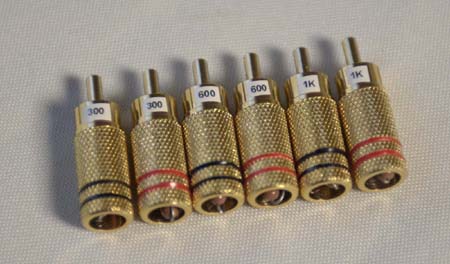
Precision matched phono cartridge loads (+/-0.25%) are easily installed on the rear panel. No need to open the case, locate or match resistors as is the case with other phono preamps. The Archival Phono Stage comes standard with 300, 600, 1000, and 47000 Ohm loads. Any phono load can be custom fabricated to meet your needs for the ultimate in modular design, ease of use, and flexibility.
Feature: The Archival Phono Preamp can be configured for use with up to three tonearm inputs (either a multi-arm turntable with up to three arms, or up to three single-arm turntables). Each of the three phono inputs have modular and independent cartridge loading. Changing between tonearms requires nothing more than a simple selection from the front panel.
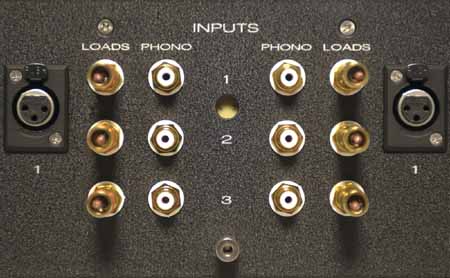
In the center of the rear panel are three phono inputs. Just to the outside of each input connector is the plug-in phono cartridge load. One phono input is configured for either RCA or XLR inputs.
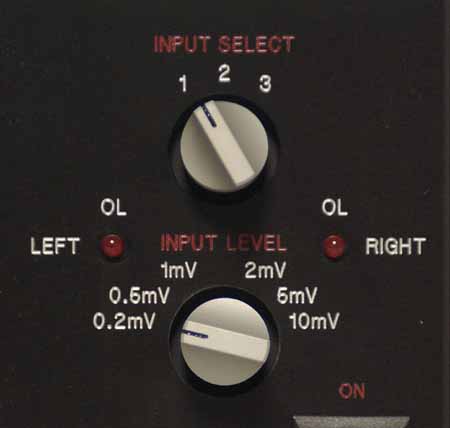
Any of the three phono inputs can be selected from the front panel. In addition, a wide range of phono input levels can be used with the Archival Phono Stage.
Feature: Phono cartridge inputs from 0.2 mV to 10 mV are supported (see image above). Whether you are using very low-output moving coils like the Ortofon or Lyra, or high output Shure moving magnet cartridges, the Wavestream Kinetics Archival Phono Stage can support these. No step-up transformer is used to achieve the high gains needed for low-output cartridges, eliminating roll-off, distortion and resonance normally associated with other high-gain phono preamp designs.
Feature: Tool-less service design. No tools are required to change EQ cards, phono loads or to service tubes. Once the Archival Phono Stage is installed in your studio, you will rarely need to change EQ cards, phono loads or tubes. But should you need to, you can perform any of these operations quickly and easily.
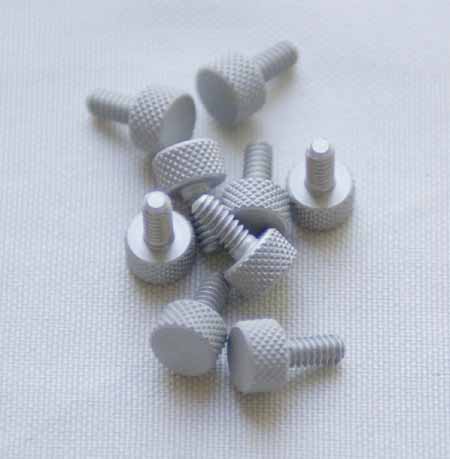
Only nine thumbscrews are between you and access to all the critical components inside the Archival Phono Stage case.
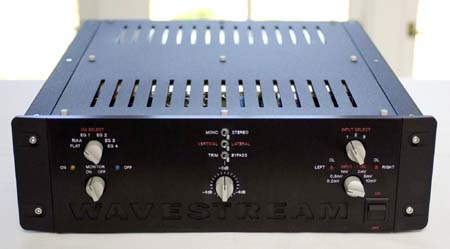
Archival Phono Stage closed. Nine tool-less thumbscrews only need be removed to open the case.
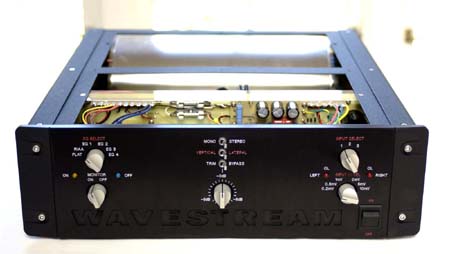
Archival Phono Stage with lid removed. Mu-metal shield is in place to protect low-level signal circuits from noise. The mu-metal shield completely encompasses the low-level signal and tube circuitry, blocking not only potential hum from the transformers, but also RFI (Radio Frequency Interference) and EMI (Electromagneitc Interference) within the room.
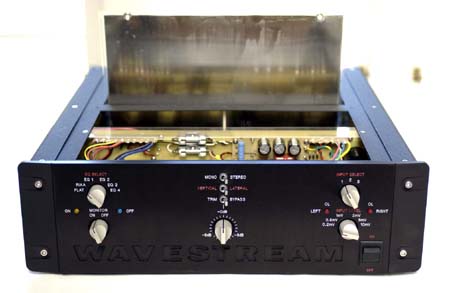
Archival Phono Stage with mu-shield raised to provide access to noise critical circuits and components like vacuum tubes and EQ cards.
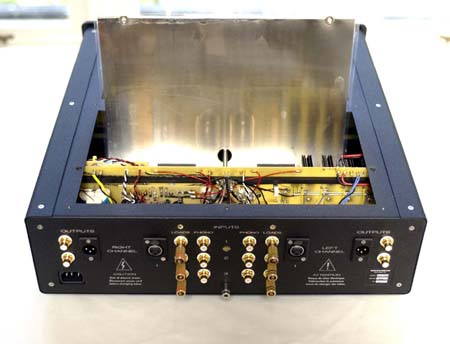
Archival Phono Stage with mu-shield raised. View from the rear.
Feature: Case with rounded edges and corners for easy handling. In a professional facility, equipment might get moved around frequently based on project needs or maintenance and service of the facility. If you've cut, pinched and bruised yourself when moving heavy gear around, you'll find the Archival Phono Stage an unexpected pleasure to work with. Details matter in a professional environment. Even the textured powder coat finish was chosen for its texture and non-slip properties when handling.
Feature: Large form factor for optimal electronic layout. Analog circuit performance is as much about circuit topology and components as it is about physical layout. The Wavestream kinetics did not start at the case and work its way in, but rather the design started with electronic performance and the shape and size needed for the case followed. Form follows function. This allowed for optimal placement of sensitive low-signal circuits, shielding, transformers and other critical components for best performance.
Feature: Build quality is extremely high with constant thought given to audio performance, ergonomics, service life and ease of maintenance. From the engraved labels on the front panel controls to the gold connectors on the rear panel, only the best sounding components and circuits are used throughout. Components are mil-spec, and components are derated for maximum performance and service life. For example, resistors are specified at least 3-7 times below their power rating and heat sinks are 2-3 times larger than needed for room temperature operation.
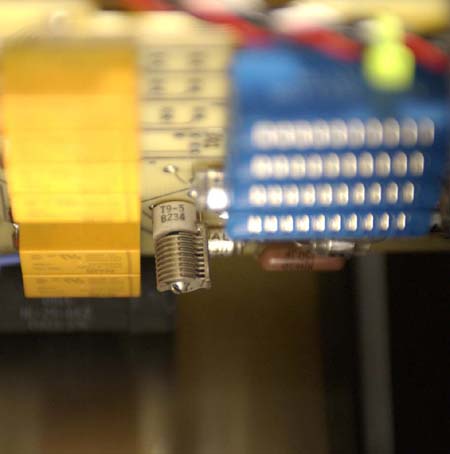
Air capacitors allow for highly precise calibration of the Archival Phono Stage. The design, performance and build quality is on par with precision scientific instruments.
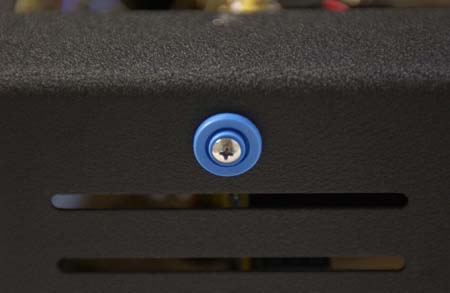
The circuit board holding the vacuum tubes uses special high-memory vibration isolation grommets to minimize tube microphonics.
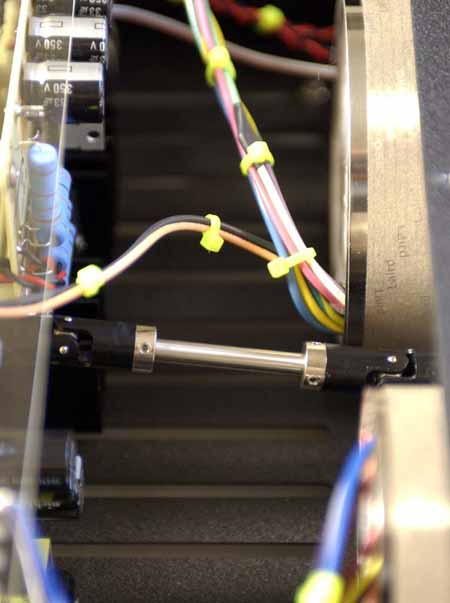
Mechanical control shafts and relays are used to keep the low-level signal paths as short as possible. On the left side of the photo are the two transformers attached to the front of the case, as far as possible from the mu-metal-shielded low-signal electronics.
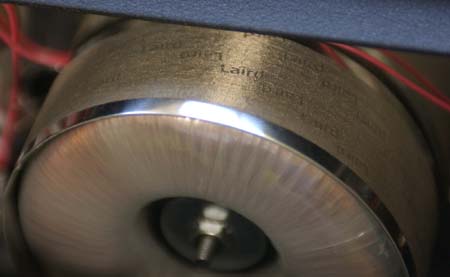
Power transformers are located inside the case rather than outboard to keep wiring between the power supply and audio circuit short and therefore quiet. The transformers are dramatically over-sized and as a result are nearly vibrationless.

Little details, like the tool-less binding post for the phono ground cables make a big difference when you are re-configuring your system and working in tight quarters.
The Wavestream Kinetics Archival Phono Stage always includes RIAA and FLAT equalizations. Inside the case, there are four card slots for up to four additional modular EQ cards that can be purchased as options. You can have as many EQ cards as you like, but only four EQs can be installed at any one time in the Archival Phono Stage.
Each EQ is designed around known and well-documented standards, or can be specified by the customer in terms of:
- Low-bass time constant (optional)
- Bass time constant (required)
- Treble time constant (optional)
Customers can also specify an EQ by:
- Low-Bass turnover frequency (optional)
- Bass turnover frequency (required)
- Treble turnover frequency (optional) or
- Treble roll-off at 10 kHz (optional)
For those less technical, we can help you select EQs if you can provide us with:
- Record label
- Year or matrix number
- Images of the markings in the label surround (groove run-out area)
Yet another alternative would be to send us a sample record for testing at The Audio Archive.
Depending on your goals and proficiency with your DAW (Digital Audio Workstation) software (ie. Digidesign ProTools, Steinberg WaveLab, Adobe Audition, Sony SoundForge, Audacity, etc.), we can help tailor a hybrid EQ solution consisting of analog EQ with the Wavestream Kinetics Archival Phono Stage and digital EQ with your DAW plug-ins.
Every EQ-related resistor and capacitor is mached in a two-step channel matching process. Resistors and capacitors are first matched within 1% (0.1dB). They are then sorted into left-right pairs that are within 0.1% (0.01dB). This two-step channel matching is highly beneficial to image focus because there are several critical EQ inflection points (turnovers) throughout the audio band. Without extremely tight matching between channels, the stereo image can shift if there are even slight differences between the left and right channel EQ, pulling instruments and voices away from their proper location on the soundstage.
This extremely tight left-right channel matching is also highly benefiicial to historic mono recordings that are transferred with stereo cartridges. The result is left and right channel gains that are more symmetric, which enhances the preservation, restoration and re-mastering process.
It can be argued that left-right channel matching may be more critical to audio performance than overall EQ accuracy. Nonetheless, the Wavestream Kinetics Archival Phono Stage has superb EQ accuracy as well:
FLAT EQ
- +/-0.1 dB from 10 Hz to 30,000 Hz
- -3 dB at 4 Hz and 45,000 Hz
- 60 dB gain max @ 1 kHz
RIAA EQ
- +/-0.15 dB from 20 Hz to 20,000 Hz
- 62 dB gain max @ 1 kHz
Vintage EQ
- +/-0.25 dB across the specified band
We asked Scott Frankland to tell us a little about the electronic design behind the Archival Phono Stage without getting too technical. Below, Scott takes us briefly through the audio circuit and power supply.
Three of the most useful specifications are impedance, gain, and noise. The Phonostage output impedance is 200 ohms. This is achieved without a cathode follower (buffer stage). A 200-ohm output impedance allows the Archival Phono Stage to drive long runs of cable with negligible effect on frequency response.
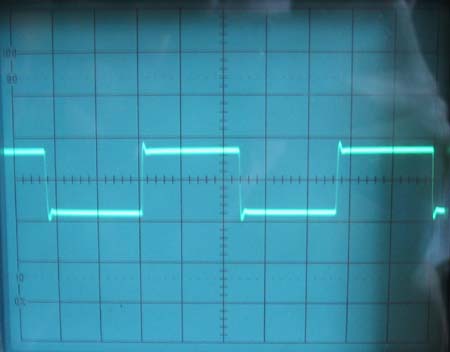
10 kHz square wave into 1,000 pF load - demonstrates insensitivity to load capacitance with long cables. This 1,000 pF load is worst case, as most cables have resistance as well, which will reduce the already small peak on the leading edge of the square wave. Note how sharp the corners are on the square wave is - it requires 250,000 to 300,000 Hertz of bandwidth to achieve this kind of performance.
The phono stage gain is as much as 62 dB (RIAA EQ) and 60 dB (FLAT EQ). This level of gain results in up to1000 times the input voltage. For example, with a 0.25 mV cartridge signal, the Archival Phono Stage output would be 250 mV (0.25 V). Here is an on-line gain calculator for converting between voltage and dB.
The Archival Phono Stage is designed to be 2-3 times quieter than conventional tube phono stages. Some of the reasons for this improved noise performance include:
- parallel cascode input stage
- power supply noise below 1 microvolt (one-millionth of a volt)
- low-noise resistors
- mechanical decoupling of the audio board from the chassis
It is also worth noting that there are no electrolytic capacitors in the audio circuit. Film capacitors offer better high frequency performance and temperature stability than electrolytic capacitors, which are commonly found in solid-state audio circuits.
The Wavestream Kinetics Archival Phono Stage features an all-tube audio circuit with no extraneous gain stages, step-up devices, transformers, cathode followers, or input FETs.
Only the power supplies contain solid-state devices, which are chosen for their high speed, low noise, and DC stability. The power supply circuits are divided into three distinct circuits:
- Input filtering
- AC line stabilization
- Audio circuit load regulation
Each Wavestream Kinetics phono preamp circuit is optimized for its job. The audio circuit load regulator is located directly on and symmetrically in the middle of the audio board to maximize the power supply response to audio signal demands, while the input filtering and AC line stabilization circuits are located on a separate power supply board.
The power supply literally supplies the load current drawn by the audio circuit in accordance with signal demands. The audio signal is superimposed on the power supply current and appears at the main output in amplified form. The power supply therefore provides the underlying "juice" that becomes the output signal. It is important that the supply current be as pure (noise-free) as possible, and that it respond to signal demands without delay or overshoot. Only fast, well-damped power supplies can give musical transients the snap and speed of live instruments.
In our quest to deliver state-of-the-art disc transfers, we invested in what were considered to be the best archival phono preamps available on the market, some costing as much as five-figures. Although these archival phono preamps had good performance specifications on paper, the subjective sound quality was lacking, particularly in the areas of imaging, tone and dynamics. The sound quality was certainly not what we considered state-of-the-art, particularly when compared with what was available in the audiophile world for LP playback.
And so in early 2005 we began our search for a better archival phono preamp…
With the help of Brian Hartsell, owner of The Analog Room in San Jose and owner of Wavestream Kinetics, we auditioned a wide range of high-end phono preamps with a very well sorted out reference room and system (SME, Graham Engineering, Koetsu and Lyra, Avalon) along with carefully selected reference recordings from the 20,000 LP collection housed at The Analog Room.
In our A-B testing of a myriad of phono preamps, I was surprised that it was the tube-based phono stage designs that consistently delivered the most realistic and musically engaging sonic performances in terms of dynamics, tonal accuracy, and imaging. Knowing what I know now about vacuum tube technology, I should not have been so surprised.
Having finally decided upon a tube-based platform for an archival phono stage, was there a manufacturer willing to build one? And build the phono stage to some very challenging performance and feature specifications?
The Wavestream Kinetics phono stage was one of our favorites during the listening tests. We approached Scott Frankland, principal designer and production manager at Wavestream Kinetics, to see if he thought it would be possible to build the Archival Phono Stage to our rigorous specifications and feature set. As it turns out, Scott was just as passionate about the idea of an audiophile quality pre-RIAA phono stage as we were.
Four years and several prototypes later, the Wavestream Kinetics Archival Phono Stage is finally in production. Along the way we talked to major sound archives, record labels, and Grammy-winning audio engineers to learn what would be important to them in an archival phono preamp. Together with Scott Frankland’s careful design, testing and engineering, we incorporated most of their suggestions into the final Archival Phono Stage.
Either solid-state or vacuum tubes can be used to create excellent sounding audio equipment. Both technologies, when operated within their linear performance regions, can be made to perform comparably and can sound quite similar. However, vacuum tubes have certain advantages when interfacing with electromechanical transducers (microphones, speakers, phono cartridges, and guitar pick-ups) in terms of power and distortion. Tubes can be driven harder with less feedback, giving good tube designs more dynamic range and lower distortion over solid-state designs under the same circumstances.
For a more in-depth discussion of solid-state versus vacuum tubes, we’ve assembled a compendium of resources.
Scott Frankland and Wavestream Kinetics
It is not possible to talk about the Wavestream Kinetics Archival Phono Preamp without talking about Scott Frankland. To get an initial sense of just how deep Scott’s knowledge of audio engineering goes and his design philosophy, the Positive Feedback interview is a good start.
Scott Frankland is not a newcomer to the high-end audio industry. Scott founded MFA with Bruce Moore decades ago. The MFA preamps and amplifiers are still legendary in audiophile circles. Head over to Audiogon and search for used MFA equipment and you will see how well these products have retained their value after 20 years or more. In fact, the phono stage found in the MFA MC Reference preamplifier - a Stereophile A-rated component (Stereophile, 17:1, Jan 1994, pp 100-103) - provided the seed for what has become today's Wavestream Kinetics Archival Phono Stage.
You may have seen articles by Scott Frankland in audiophile publications like Ultimate Audio, Positive Feedback, The Audio Adventure, Glass Audio, Vacuum Tube Valley, The Inner Ear Report (Canada), Audio Express, Absolute Sound and The Listener. Scott published a nice three-part series in Stereophile on “Single-Ended vs Push-Pull” amplifier design (Stereophile, 19:12, Dec 1996, pp. 110–121, 20:1, Jan 1997, pp. 123–141, 20:2, Feb 1997, pp. 80–97).
Not only does Scott have extensive knowledge about current vacuum tube practices, but he also has an excellent understanding of the history of vacuum tubes all the way back to the 1920s. Scott has researched and produced an on-line survey of the classic vacuum tube texts, as well as a detailed 34-page PDF compendium.
Scott is also known for his custom modifications of audiophile vacuum tube equipment, and has intimate knowledge of most every major manufacturer’s designs, and understands their strengths and their weaknesses. Scott has also consulted on the designs of some big-name pro-audio company gear.
It's not enough that Scott understands the past and present of vacuum tube design and technology, but he is also creating the future with his two vacuum tube circuit patents:
Single-ended screen-regulated cathode-follower output stage for high-fidelity music amplifier (2009)
All of this experience has helped Scott and Wavestream Kinetics produce both the evolutionary and revolutionary Wavestream Kinetics Archival Phono Stage.
Each Wavestream Kinetics Archival Phono Stage comes shipped in a custom re-usable crate. The crate is designed to protect the electronics from even the roughest handling by overseas shippers. Fully crated, the Archival Phono Stage weighs just over 30 pounds.
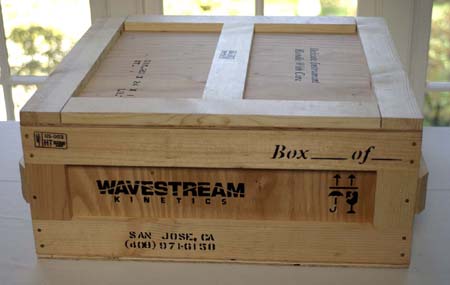
The compact crate includes built-in carrying "bars" (on the left and right sides in the photo) for easy handling by shippers and customers. Small details matter.
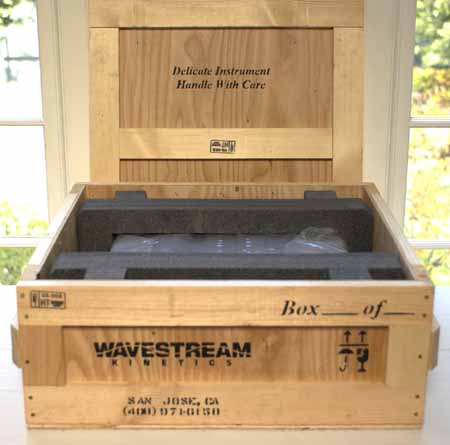
Professional packaging and labeling ensure safe arrival of your Wavestream Kinetics Archival Phono Stage.
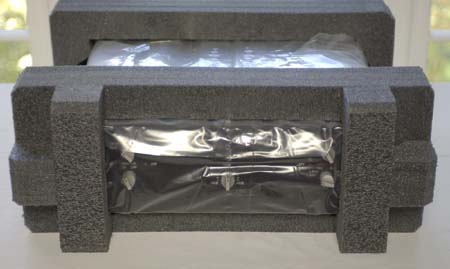
Custom packaging surrounds and protects the Archival Phono Stage from the shocks of rough handling.
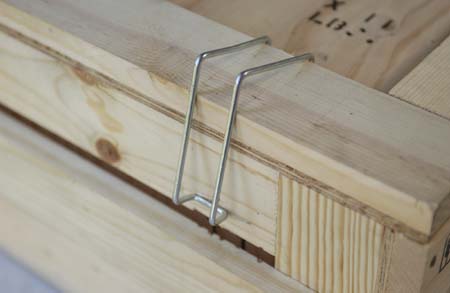
The use of clips instead of nails, staples or screws makes the shipping crate easy to open and close with simple tools, yet is fully secure in transit. The crates can be re-used many times over with the clip system.
Q1: Is The Audio Archive and Wavestream Kinetics the same company?
A1: No, The Audio Archive and Wavestream Kinetics are two different companies. The Audio Archive is a service company and system integrator (we integrate systems that are made up of equipment from a variety of manufacturers), whereas Wavestream Kinetics is an equipment manufacturer. Because The Audio Archive and Wavestream Kinetics have complimentary skills and capabilities, we decided to work together to create the Archival Phono Stage. The Audio Archive provided the customer and market experience needed to specify the functionality and performance, and Wavestream Kinetics provided the design solutions and then finally manufactured the Archival Phono Stage. Aside from working closely together to develop the Archival Phono Stage, there is no fiduciary relationship between the two companies.
Q2: Where can I listen to and purchase the Archival Phono Stage?
A2: The Audio Archive demonstrates The Archival Phono Stage at appropriate industry conferences throughout the year. The Archival Phono Stage can also be demonstrated by appointment at The Audio Archive.
The Audio Archive is the exclusive worldwide distributor for the Wavestream Kinetics Archival Phono Stage within the commercial (record labels, film companies, preservation and restoration companies and individual service providers) and institutional markets (sound collections, libraries, government, for-profit and non-profit organizations).
Q3: If a vacuum tube degrades or fails, what do I do?
A3: The Archival Phono Stage is shipped with a second set of precisely matched tubes so that any failure in the field can be remedied immediately. In addition, Wavestream Kinetics has mapped the gain stages of each Archival Phono Stage by serial number so that tubes can be matched at Wavestream Kinetics without your unit being returned for service.
Q4: Does the Archival Phono Stage require regular maintenance?
A4: Yes. We recommend that you ship your Archival Phono Stage back to Wavestream Kinetics for a routine service check every third year. Wavestream Kinetics will make sure that your Archival Phono Stage continues to meet the same specifications as it did when new. The Archival Phono Stage is designed and maintained like a precision laboratory instrument, where the equivalent of regular recertification of the equipment by the manufacturer will guarantee that performance always meets specifications.
Q5: Can the Archival Phono Stage be upgraded as new features and capabilities are developed, or as my needs change?
A5: Yes. Due to the modular design, elements of the Archival Phono Stage can be upgraded and modified for a fee to meet your needs without having to replace the Archival Phono Stage.
Meet with Us
Find out when and where we will be displaying the Wavestream Kinetics Archival Phono Stage.
For more product information, please write:
or call us at:
+1 (408) 221-2128
